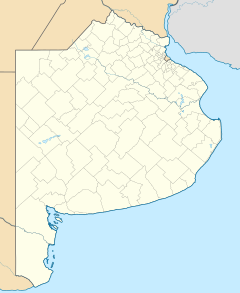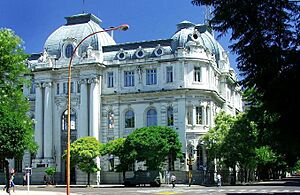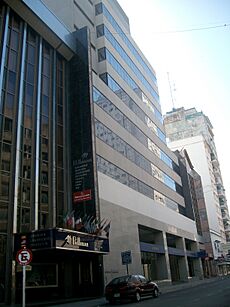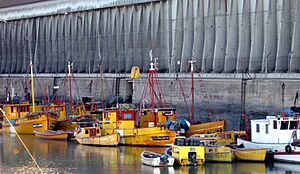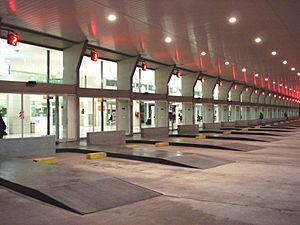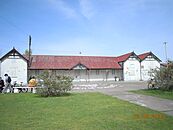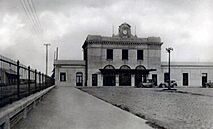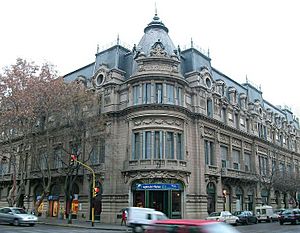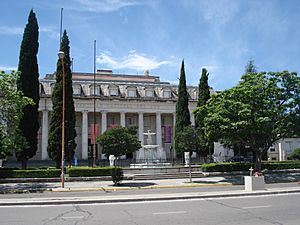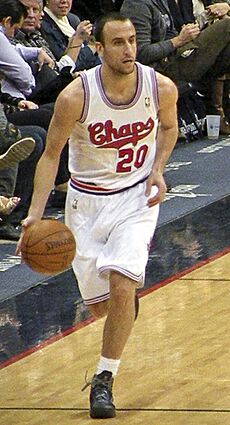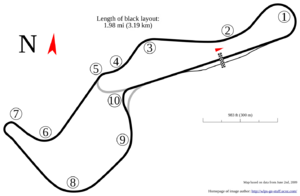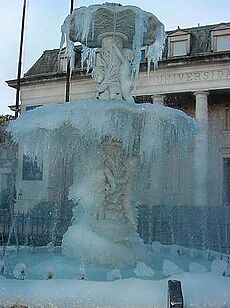Bahía Blanca facts for kids
Quick facts for kids
Bahía Blanca
|
|||
|---|---|---|---|
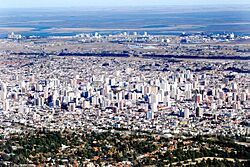
Panoramic view of Bahía Blanca
|
|||
|
|||
| Country | |||
| Province | |||
| Partido | |||
| Founded | 1828 | ||
| Area | |||
| • City | 2,247 km2 (868 sq mi) | ||
| Elevation | 20 m (70 ft) | ||
| Population
(2010 census [INDEC])
|
|||
| • Urban | 301,572 | ||
| Time zone | UTC−3 (ART) | ||
| CPA Base |
B 8000
|
||
| Area code(s) | +54 291 | ||
| Climate | Cfa | ||
| Website | Official website: https://www.bahia.gob.ar/ | ||
Bahía Blanca is a city located by the Atlantic Ocean in the southwest of Buenos Aires Province, Argentina. It's the main city in the Greater Bahía Blanca area, with over 300,000 people living there.
The city has a very important seaport. Its name, Bahía Blanca, means "White Bay" because of the salt that covers the soil around the shores. The bay was first seen by Ferdinand Magellan in 1520 while he was exploring for a way to connect the Atlantic and Pacific Oceans.
Contents
History of Bahía Blanca
How the City Started
Bahía Blanca began as a fortress on April 11, 1828. It was called Fortaleza Protectora Argentina. Colonel Ramón Estomba built it to protect people from cattle thieves and to guard the coast. Famous scientist Charles Darwin visited the fortress in September 1833 during his travels.
The fortress was attacked several times by Malones, who were groups of nomadic aboriginals. One big attack happened in 1859 by 3,000 Calfucurá warriors. The city became important for trade after a railway connected it to Buenos Aires in 1885. This made it easier to transport grain from the Pampas region.
Growth and New Settlers
The economy grew quickly, and many people from Europe came to live in Argentina. Most immigrants came from Spain and Italy, but also from France, Germany, and Eastern Europe (including Jewish people). They settled in Bahía Blanca and nearby towns. These new settlers brought their customs and culture. For example, in the early 1900s, Bahía Blanca had at least five opera houses and six cinemas by 1920.
Puerto Belgrano, located about 29 km southeast of Bahía Blanca, is Argentina's largest naval base. Its construction began in 1898 and was finished in 1902.
How Bahía Blanca is Governed
The city of Bahía Blanca is run by a local government. This includes a mayor, who leads the executive branch, and a city council. The city council helps create local laws and checks the city's budget. There is also a local court system that handles justice for city laws. The mayor and council members are chosen by direct vote.
Economy and Trade
Bahía Blanca is a very important center for trade and business. It handles a lot of exports like grains and wool from Buenos Aires Province. It also exports oil from Neuquén Province and fruit from the Río Negro Valley.
Important Seaports
The city's seaports are some of the most important in Argentina. They are naturally deep, which is great for big ships. The main ports are Puerto Ingeniero White, used for grains and containers, and Puerto Galván, which specializes in sunflower and soy oil, and chemicals. A large company called Profertil, which makes urea (a type of chemical), is also located here. Many industrial and chemical plants have their own piers between these two main ports.
The port area is also connected by a railway network that helps transport goods. This, along with available energy and skilled workers, makes Bahía Blanca an attractive place for industries and businesses.
Local Businesses and Shopping
Local groups like the Sociedad Rural and Corporación del Comercio y de la Industria organize events and exhibits. These often showcase farming, trade, and industry. For example, the "Exposición Nacional de Ganadería e Industria" has been held for over 120 years, giving awards to the best animals.
For shopping, there are many stores in the city center. There are also two shopping centers on the outskirts of the city. On Saturdays, you can find a craftsmanship fair in Plaza Rivadavia, the main square, where people sell handmade goods.
Getting Around Bahía Blanca
Air Travel
Bahía Blanca has an airport called Comandante Espora Airport. There are daily flights to Buenos Aires. The airport's runways are also used by the Navy. The civilian part of the airport is currently being updated.
Bus Travel
The city's bus terminal has been recently updated. It offers bus services to many cities and towns across Argentina and even to nearby countries like Uruguay.
Roads
Several main roads meet in Bahía Blanca, connecting it to the rest of the country. For example, Ruta Nacional 3 goes north to Buenos Aires and south to cities like Viedma and Ushuaia. Other routes connect to places like Santa Rosa and Rosario. There are also local bus lines for getting around the city.
Railway
Bahía Blanca has three railway stations, but as of 2024, they don't have passenger train services. The last active station was Bahía Blanca Sud, which was built in 1884. Train services from Buenos Aires to Bahía Blanca stopped in 2022.
The other two stations were built by British and French companies. One of them, the FCRPB station, was used as the municipal library until it was destroyed by fire in 2022.
| Name | Former Company | Ceased oper. | Status |
|---|---|---|---|
| Bahía Blanca Sud | BA Great Southern |
|
Closed |
| Bahía Blanca | Rosario & Pto. Belgrano |
|
Closed |
| Bahía Blanca | BB & North Western |
|
Destroyed |
Architecture and Landmarks
The city's design is typical of those founded by the Spanish. It has a main square in the center, surrounded by important buildings like the City Hall and the Church. The streets are mostly straight and form rectangular blocks.
Many public buildings in Bahía Blanca are known for their beautiful architecture. Examples include the National Bank, the Bolsa de Comercio de Bahía Blanca (Chamber of Commerce), the main Post Office, and the Universidad Nacional del Sur. Many of these buildings are well-preserved and show influences from French neoclassical style.
The city also has many impressive monuments and sculptures. You can find them in the streets, main buildings, and parks. Some famous ones include the Memorial to Bernardino Rivadavia in the main square and the sculpture group by Lola Mora at the entrance of the Universidad Nacional del Sur. These artworks add to the city's rich artistic and cultural heritage.
Bahía Blanca has many green spaces and parks, such as Plaza Rivadavia, Parque de Mayo, and Paseo de las Esculturas. There are also interesting neighborhoods like the Barrio Inglés (English Quarter), where British railway and port workers used to live.
Culture and Education
Bahía Blanca is a city with a strong focus on culture and education. It has its own Symphony Orchestra and a Classical Ballet Company called Ballet del Sur, which also has a dance school.
Higher Education
For further studies, there are two national universities:
- Facultad Regional Bahía Blanca Universidad Tecnológica Nacional: This university focuses on exact sciences and is for students who might also be working.
- Universidad Nacional del Sur (National University of the South): Founded in 1956, this university has research institutes in biological, biochemical, and technological sciences. Both national universities offer free tuition for all students. Nobel Prize winner César Milstein was born and grew up in Bahía Blanca.
Schools and Languages
Basic education in Bahía Blanca is managed by the Province of Buenos Aires. There are public, semi-private, and private schools. The city also has respected provincial schools for Plastic Arts and Music, which are free.
Many foreign language schools teach English, French, Italian, German, and Portuguese. These schools help students learn new languages and cultures.
Libraries and Museums
The main public library is Biblioteca Bernardino Rivadavia, which has a large collection of books, newspapers, and magazines. The Universidad Nacional del Sur also has a library open to the public.
Bahía Blanca has several museums, including the Port Museum, History Museum, Fine Arts Museum, and Contemporary Arts Museum. These museums display art from local and Argentine artists. You can also find a military museum organized by the Army, which shows a small model of the original fortress and old maps. All museums in the city offer free admission.
Publications
The city has a local newspaper called La Nueva Provincia. There are also scientific journals and reports about the city's economy.
Entertainment
Bahía Blanca offers many entertainment options like cinemas, discos, restaurants, and pubs. You can also enjoy plays, ballet performances, and concerts.
The city has two zoos, one municipal and one private. Near the city, there are recreational areas by the shores, like "Balneario Maldonado". The bay area is also a protected natural reserve, where fishing for sharks is a popular activity in specific areas.
Religion
Most people in Bahía Blanca are Roman Catholic. However, there are also Protestant churches and a synagogue. The city is known for being religiously tolerant, which is a common feature in Argentina.
The city is home to the Archdiocese of Bahía Blanca. Its main church is the Our Lady of Mercy Cathedral. The Archbishop leads the local branch of Caritas, a charity organization that helps people in need.
Sports
Bahía Blanca is famous for its sports, especially basketball.
Basketball
Since the 1950s, Bahía Blanca has been known as a top city for Argentine basketball. Many internationally famous players come from here, including Manu Ginóbili (a four-time NBA champion with the San Antonio Spurs) and Juan Ignacio Sánchez. Both were part of the Argentine team that won a gold medal at the Olympic Games in Athens in 2004.
Football (Soccer)
The city's main football (soccer) teams are Olimpo and Villa Mitre. Famous football players like Rodrigo Palacio and Lautaro Martínez (who plays for Argentina and Internazionale Milan) were born in Bahía Blanca.
Other Sports
You can find facilities for playing football, tennis, rugby, golf, and swimming. There are also two large indoor basketball stadiums and three football stadiums. The city also has two of the best padel players in the world, Juan Mieres and Miguel Lamperti.
Healthcare
Bahía Blanca has very low rates of illiteracy and infant mortality, which means people are well-educated and babies are healthy. The city has two main hospitals: Hospital Dr José Penna (provincial) and Hospital Municipal Dr Leónidas Lucero (municipal). Both are major centers for medical care in the region. Healthcare is free for legal residents of Argentina. There are also many public clinics and private healthcare centers.
Climate
Bahía Blanca has a subtropical climate, meaning temperatures can change a lot. It's influenced by being close to the ocean.
Seasons
- Winters are cool during the day and cold at night. Snow is rare, but it can happen. There are usually about 35 days with frost each year.
- Spring and Fall have mild temperatures during the day and cool to cold nights. Frosts can sometimes happen during these seasons, which can affect crops.
- Summers are warm during the day and mild to cool at night. Most of the rain happens in the summer, often with thunderstorms. Summers are usually sunnier.
The city gets about 645 mm (25 inches) of rain per year, mostly in summer. Winds are moderate throughout the year. The highest temperature ever recorded was 43.8°C (110.8°F) in January 1980, and the lowest was -11.8°C (10.8°F) in July 1988.
| Climate data for Bahía Blanca airport (1991–2020, extremes 1860–present) | |||||||||||||
|---|---|---|---|---|---|---|---|---|---|---|---|---|---|
| Month | Jan | Feb | Mar | Apr | May | Jun | Jul | Aug | Sep | Oct | Nov | Dec | Year |
| Record high °C (°F) | 43.8 (110.8) |
41.3 (106.3) |
40.1 (104.2) |
36.7 (98.1) |
32.8 (91.0) |
27.8 (82.0) |
27.0 (80.6) |
32.6 (90.7) |
32.5 (90.5) |
39.0 (102.2) |
38.4 (101.1) |
42.2 (108.0) |
43.8 (110.8) |
| Mean daily maximum °C (°F) | 31.2 (88.2) |
29.6 (85.3) |
27.0 (80.6) |
22.0 (71.6) |
17.7 (63.9) |
14.5 (58.1) |
13.9 (57.0) |
16.5 (61.7) |
18.9 (66.0) |
22.1 (71.8) |
26.0 (78.8) |
29.7 (85.5) |
22.4 (72.3) |
| Daily mean °C (°F) | 23.6 (74.5) |
22.1 (71.8) |
19.6 (67.3) |
15.1 (59.2) |
11.4 (52.5) |
8.4 (47.1) |
7.6 (45.7) |
9.6 (49.3) |
11.8 (53.2) |
15.0 (59.0) |
18.7 (65.7) |
22.0 (71.6) |
15.4 (59.7) |
| Mean daily minimum °C (°F) | 16.3 (61.3) |
15.2 (59.4) |
13.4 (56.1) |
9.4 (48.9) |
6.4 (43.5) |
3.5 (38.3) |
2.4 (36.3) |
4.1 (39.4) |
5.6 (42.1) |
8.5 (47.3) |
11.6 (52.9) |
14.5 (58.1) |
9.2 (48.6) |
| Record low °C (°F) | 2.4 (36.3) |
1.0 (33.8) |
−1.5 (29.3) |
−3.4 (25.9) |
−6.4 (20.5) |
−9.8 (14.4) |
−11.8 (10.8) |
−7.9 (17.8) |
−7.3 (18.9) |
−4.5 (23.9) |
−1.5 (29.3) |
0.5 (32.9) |
−11.8 (10.8) |
| Average precipitation mm (inches) | 66.2 (2.61) |
69.4 (2.73) |
70.6 (2.78) |
53.2 (2.09) |
41.5 (1.63) |
32.6 (1.28) |
32.4 (1.28) |
31.7 (1.25) |
45.0 (1.77) |
69.5 (2.74) |
62.3 (2.45) |
64.7 (2.55) |
639.1 (25.16) |
| Average precipitation days (≥ 0.1 mm) | 6.9 | 6.5 | 7.4 | 6.8 | 5.6 | 6.0 | 5.5 | 4.9 | 6.2 | 8.8 | 7.2 | 6.6 | 78.4 |
| Average snowy days | 0.0 | 0.0 | 0.0 | 0.0 | 0.1 | 0.1 | 0.1 | 0.1 | 0.0 | 0.0 | 0.0 | 0.0 | 0.3 |
| Average relative humidity (%) | 53.0 | 59.4 | 65.3 | 69.9 | 75.2 | 73.4 | 72.3 | 67.0 | 65.2 | 64.9 | 58.1 | 52.0 | 64.6 |
| Mean monthly sunshine hours | 310.0 | 262.7 | 248.0 | 198.0 | 161.2 | 138.0 | 148.8 | 176.7 | 195.0 | 235.6 | 273.0 | 313.1 | 2,660.1 |
| Mean daily sunshine hours | 10.0 | 9.3 | 8.0 | 6.6 | 5.2 | 4.6 | 4.8 | 5.7 | 6.5 | 7.6 | 9.1 | 10.1 | 7.3 |
| Percent possible sunshine | 67 | 66 | 52 | 57 | 40 | 38 | 36 | 44 | 44 | 49 | 58 | 58 | 51 |
| Source 1: Servicio Meteorológico Nacional | |||||||||||||
| Source 2: Meteo Climat (record highs and lows), Oficina de Riesgo Agropecuario (record lows), UNLP (percent sun only 1971–1980) | |||||||||||||
Consulates
Bahía Blanca hosts several foreign consulates, including those from Spain, Italy, and Chile. There are also honorary consulates for France, Denmark, Norway, and the Netherlands.
Famous People from Bahía Blanca
Many well-known people were born or lived in Bahía Blanca:
- Alfio Basile (born 1943): A former Argentinian Football Coach.
- Daniel Bertoni (1955): A footballer who won the 1978 FIFA World Cup.
- Cecilia Bouzat (born 1961): A biochemist recognized as one of 100 Women (BBC).
- Manu Ginóbili (born 1977): A Basketball Hall of Fame member and former NBA player who won an Olympic Gold medal in 2004.
- Lautaro Martínez (born 1997): A footballer who won the 2022 FIFA World Cup.
- César Milstein (1927–2002): A Nobel Prize in Physiology or Medicine winner.
- Rodrigo Palacio (born 1982): A footballer who plays as a forward.
- Carlos di Sarli (1903–1960): A famous Argentine tango musician and composer.
See also
 In Spanish: Bahía Blanca para niños
In Spanish: Bahía Blanca para niños




